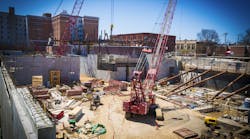Latest from Commercial Plumbing
Sponsored
Danforth Co. wraps up huge medical facility job
BUFFALO, NEW YORK — A seven-story atrium, 650,000 square feet of classrooms and labs, and a whopping $375 million budget: The University at Buffalo’s new Jacobs School of Medicine facility has been a lofty project, to say the least. The building’s mechanical, HVAC and plumbing work — the heart of the facility — is on an enormous scale.
“At the peak of this job we had about 170 of our workers on the site,” said Matt Peters, John W. Danforth Co. project manager. “It’s the single largest contract we’ve ever executed in our 133-year history.”
Founded in 1884, Danforth is a mechanical contracting company based out of Tonawanda, New York, with locations in Buffalo, Rochester, Syracuse, and Albany. Working in industrial, commercial and residential areas, Danforth is one of the largest mechanical contractors in the Northeast. The company works in HVAC, refrigeration and plumbing. In addition to mechanical contracting, they have expertise in design and building, energy performance contracting, power and specialty offerings. Danforth is ranked number 39 in CONTRACTOR’s annual Book of Giants listing of the nation’s largest mechanical contractors.
Peters and his crew started Danforth’s portion of the medical facility construction during the spring of 2015, which included installing HVAC and plumbing lines throughout the entire eight-story structure. Hundreds of miles of pipe later, the terra cotta-clad building is now open to faculty and will welcome students for the spring 2018 semester.
Like many projects this size, efficiency was paramount to keeping things moving along, and the Danforth team knew optimizing efficiency meant having the right equipment that would allow them to quickly and safely install the materials.
The project scope
“Scissor lifts are critical tools for our jobs,” said Michael Folaron, Danforth’s lead foreman. “We knew our standard 19-foot units wouldn’t be ideal for this project. We needed lifts that could easily get into and out of shorter, more confined interior spaces, as well as provide the capacity and set up that would ease the installation process.”
Much of Danforth’s work took place in areas with 15-ft. ceiling heights where a standard 19-ft. lift would have been overkill, created a crushing hazard and been a challenge to maneuver. Danforth worked with ADMAR Construction Equipment and Supplies, a New York-based rental company, on a solution.
“We recommended the Hy-Brid 14-ft. lifts because, like most jobs, the majority of the installations on this project didn’t call for a working height higher than 19 ft., which means a 12- to 14-ft. platform height lift was sufficient,” said Jason Colby, ADMAR Supply territory manager. “The 14-ft. lifts are compact so they’re easy to drive through confined spaces and there’s minimal crushing hazard risk. Still, they offer plenty of capacity for tools and supplies.”
In addition to maneuvering through numerous labs and classrooms across multiple floors, the crews had to use the lifts on future stair landings, which meant as many as six elevation changes on one floor. With a 19-ft. lift Danforth would have had to use a fork truck to get the lift onto each landing, which would have added costs and hassle to the project. Instead, because the lifts are relatively lightweight, the crew used chains to swing them up onto the landings.
“We saved time and money when it came to getting the lifts into the building,” Peters added. “Our crew was able to use a hoist rather than rent a larger, more-costly crane to lift the 1,645-pound lifts into the upper floors of the building.”
The challenges
Perhaps the biggest challenge the Danforth crews faced came with the sheer amount of materials they needed to install.
“The facility may be similar to other buildings in size, but its network of pipes and ductwork were some of the most intricate we’ve installed,” Peters said.
The pipe racks could hold as much as 200 lb., which allowed the installers to load them with multiple 20-ft. pipes.
Because of the facility’s sheer size and its numerous labs and classrooms, Danforth had to install a variety of HVAC piping, including lines for hot, chilled and condenser water, as well as high-pressure steam/condensate and fuel oil system lines. They also had many plumbing lines to install, including piping for domestic and tempered water as well as cold and hot non-potable water. This was in addition to reverse osmosis and deionization, animal watering, storm/overflow, lab waste and vent, reclaim and natural gas lines. And finally, carbon dioxide, oxygen and nitrogen, as well as a medical vacuum and compressed air had to be routed to each lab.
“It was a lot of material to load up and down with the scissor lifts,” Peters said. “Fortunately, Custom Equipment designed the units to make this task easier, safer and more efficient.”
Custom Equipment Inc. custom engineered a pipe rack that allowed installers to haul the maximum amount of material, in addition to two workers. Rather than weld the rack on top of the lift like an aftermarket system, which would have disrupted the machine’s balance and capability, Custom Equipment integrated the rack into the overall lift design. This meant it didn’t impact machine stability or safety.
The pipe racks could hold as much as 200 lb., which allowed the installers to load them with multiple 20-ft. pipes. This cut the number of trips up and down by one-third so installers could work faster and more efficiently. The custom pipe racks combined with the lifts’ low weight allowed two workers to be on the lift installing materials at once, speeding up production time, which would not have been possible with aftermarket pipe racks because of how the racks are incorporated onto the lift.
At the height of the project, Danforth was operating around 57 scissor lifts, which all were equipped with the custom pipe racks. The pipe racks worked so well the contractor also retrofitted several of its lifts already on site with them.
“The racks were critical to our efficiency, particularly in corridors,” Peters said. “These areas were more confined and we had to install a lot of material into some tight ceiling envelopes. Being able to have two people on the lift, in addition to an ample amount of materials, made this part of the project less cumbersome.”
In fact, the project went smoothly overall.
“We didn’t run into any issues getting the Hy-Brid Lifts in and out of areas or with repairs, which for a job this size, is telling,” Peters said. “If we get another new build or renovation project with low ceiling heights, I won’t hesitate to use them again.”
A healthy finish
The bulk of the work may be done at the University at Buffalo Medical Center, but the impact the facility will have on students will continue for many years. The labs in the building’s third, fourth and fifth floors will provide hands-on learning for thousands of students; its robotics suite on the seventh floor will give future surgeons the practical skills to complete some of the most intricate surgeries; and its surgical skills unit will prepare future doctors for the real world.
There’s one worker, the heart of the building, if you will, who will reside indefinitely in the mechanical room — the plumbing lab system. Its lifelines will extend throughout the facility, providing the carbon dioxide necessary to perform endoscopy, laparoscopy and arthroscopy procedures; the nitrogen needed for cryosurgeries; and the oxygen required to treat hypoxemia and hypoxia. And it’s all to keep the dreams of our future medical professionals alive.



